Introduction
In the heart of every Hindu household, the Aarti thali holds a place of profound significance. It is more than just a plate; it is a vessel of devotion, a carrier of our deepest prayers, and a focal point during our most sacred rituals. The gentle clinking of the bell, the warm glow of the diya, the fragrant smoke of the incense, and the vibrant offering of flowers—all come together on this sacred platter to create an experience that engages all the senses and uplifts the soul.
But have you ever considered that the act of decorating the Aarti thali itself can be a deeply spiritual and creative practice? The search for unique and beautiful Aarti Thali Decoration Ideas is a journey to enhance this divine connection, transforming a simple ritual into a breathtaking visual and spiritual offering.
This comprehensive guide is your ultimate resource for all things related to Aarti Thali Decoration Ideas. Whether you are preparing for a grand festival like Diwali, Navratri, or a simple daily pooja, the presentation of your thali can significantly amplify the sanctity and beauty of the moment. We will delve into the symbolic meaning of every element, explore a vast array of decoration styles—from the deeply traditional to the elegantly modern—and provide you with practical, step-by-step instructions.
Our goal is to empower you with inspiration and knowledge, helping you create a thali that is not only aesthetically pleasing but also rich in spiritual meaning, perfectly aligning with the cozy and inspirational essence of CozyNestDecor Aarti Thali Decoration Ideas.
Let’s embark on this beautiful journey together, exploring the art and soul of Aarti Thali Decoration Ideas.
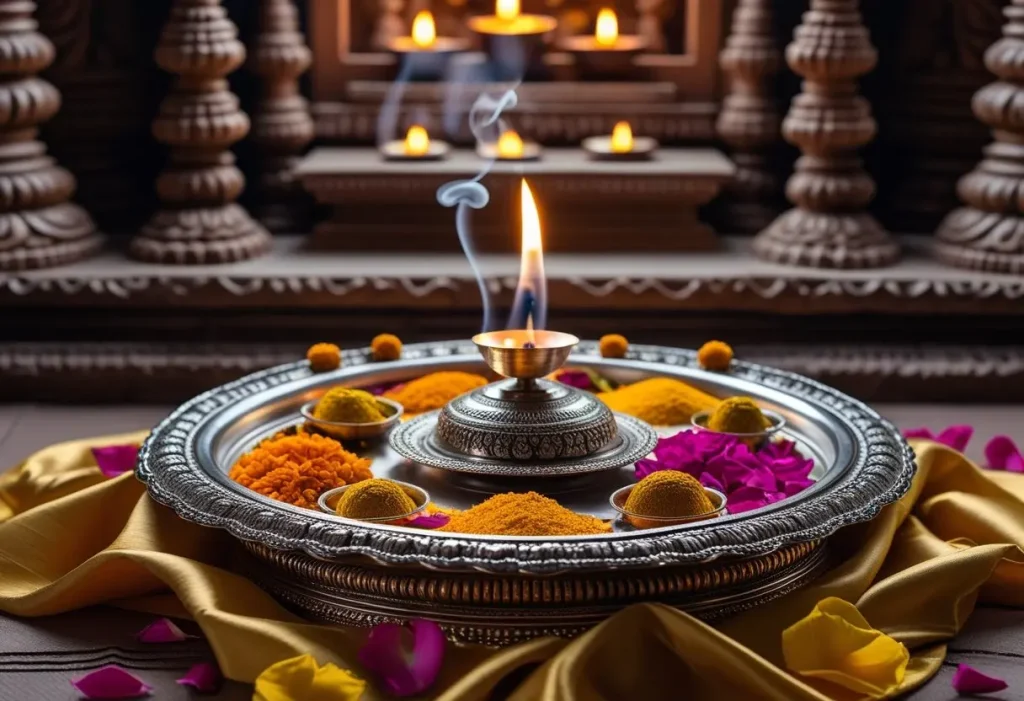
The Significance of the Aarti Thali in Hindu Rituals
Before we dive into the myriad of Aarti Thali Decoration Ideas, it is crucial to understand the ‘why’ behind the ‘what’. The Aarti ceremony is a core component of Hindu worship, and every item on the thali has a specific spiritual and philosophical significance.
What is the Aarti Ceremony?
The word ‘Aarti’ is derived from the Sanskrit word ‘Aratrika’, which means something that removes darkness (Ratrika). It is a ritual of light, a form of homage and surrender to the divine. The ceremony involves circulating a platter of lit lamps, incense, and other offerings in front of the deity. This act symbolizes the offering of the elements of the universe—earth (flowers), water, fire, air (fanning with cloth or chamara), and space (the sound of the bell and conch)—to God. It represents the realization that the divine light of the soul (Atman) is the same as the cosmic light (Brahman) Aarti Thali Decoration Ideas.
The Spiritual Meaning of Each Item on the Thali
A standard Aarti thali contains several key items, each with a deep symbolic meaning:
- The Thali (Plate): The base itself represents the entire universe, upon which all offerings are placed. It is often made of silver, bronze, or copper, metals believed to have purifying properties.
- The Diya (Lamp): The flame is the centerpiece, representing the supreme light of consciousness, knowledge, and the eternal soul. It symbolizes the destruction of ignorance and the illumination of the path to truth.
- Incense Stick (Agarbatti): Its fragrant smoke represents the element of air and symbolizes the purification of the atmosphere and the offering of our desires to the divine.
- Bell (Ghanta): The sound of the bell is said to drive away negative energies and create a sacred sound frequency that helps in focusing the mind on the divine Aarti Thali Decoration Ideas.
- Flowers & Petals: Flowers symbolize beauty, fragility, and the offering of our good deeds and virtues to God. Their fragrance and color please the senses and create a serene environment.
- Kumkum & Haldi (Vermilion & Turmeric): These sacred powders represent prosperity, purity, and the divine feminine energy (Shakti). They are used for making tilak, a mark of blessing on the forehead.
- Chandan (Sandalwood Paste): Known for its cooling properties, it symbolizes purity and devotion. It is applied to the forehead to cool the mind and enhance concentration.
- Akshata (Unbroken Rice): Rice grains mixed with turmeric represent fertility, abundance, and the fulfillment of desires. They are offered as a symbol of prosperity and life-sustaining nourishment.
- Water (Jal): A small pot or spoon of water symbolizes purity, clarity, and the source of all life.
- Coconut: A whole coconut represents the ego. Offering it to God symbolizes the surrendering of our ego to attain spiritual purity.
- Sweets (Prasad): Offering food signifies that we are offering the fruits of our labor to God and receiving it back as a blessed gift (Prasad), symbolizing grace Aarti Thali Decoration Ideas.
Understanding these meanings allows you to decorate your thali with intention, making each element a conscious part of your devotional practice.
Essential Components for Aarti Thali Decoration
Now that we understand the significance, let’s look at the physical components you’ll need. Gathering the right materials is the first step in bringing your Aarti Thali Decoration Ideas to life.
1. The Base: Choosing Your Thali
The thali itself sets the stage for your decoration. Your choice will depend on the occasion, your personal style, and the overall theme.
- Metal Thalis:
- Silver (Chandi ki Thali): Considered the most auspicious and pure. It is cooling, elegant, and perfect for grand festivals.
- Brass (Pital ki Thali): Warm, traditional, and durable. It develops a beautiful patina over time.
- Copper (Tambe ki Thali): Believed to have health benefits. It has a distinctive reddish-brown hue.
- Stainless Steel: Practical, easy to clean, and perfect for daily use.
- Other Materials:
- Wooden Thalis: Offer a rustic, earthy, and bohemian feel. Great for a minimalist or nature-themed decoration.
- Bamboo Thalis: Eco-friendly and lightweight, perfect for a sustainable decor theme.
- Terracotta Thalis: Provide a raw, organic, and traditional look, ideal for festivals like Diwali or Janmashtami.
2. The Core Pooja Items
These are the non-negotiable items for the ritual Aarti Thali Decoration Ideas.
- Diya (with ghee/oil and wick)
- Incense holder (with agarbatti)
- Bell
- Small container for kumkum
- Small container for haldi
- Small container for chandan
- A small bowl for akshata (rice)
- A small spoon or pot for water
- Camphor (optional, for a special flame)
3. Decorative Elements
This is where your creativity shines. These elements enhance the beauty without interfering with the function.
- Fresh Flowers: Marigold, roses, jasmine, lotus, chrysanthemums.
- Flower Petals: For creating a bed or patterns.
- Leaves: Mango leaves, betel leaves (Paan), or tulsi leaves.
- Rangoli Colors/Colored Sand: For creating intricate designs on the thali.
- Fabric: Small pieces of silk, brocade, or lace to line the thali or create compartments.
- Beeds, Sequins, and Stones: For adding sparkle and detail.
- Miniature Idols or Symbols: Like a small Om, Swastik, or Shree symbol.
- Diyas and Candles: Small decorative diyas for additional light Aarti Thali Decoration Ideas.
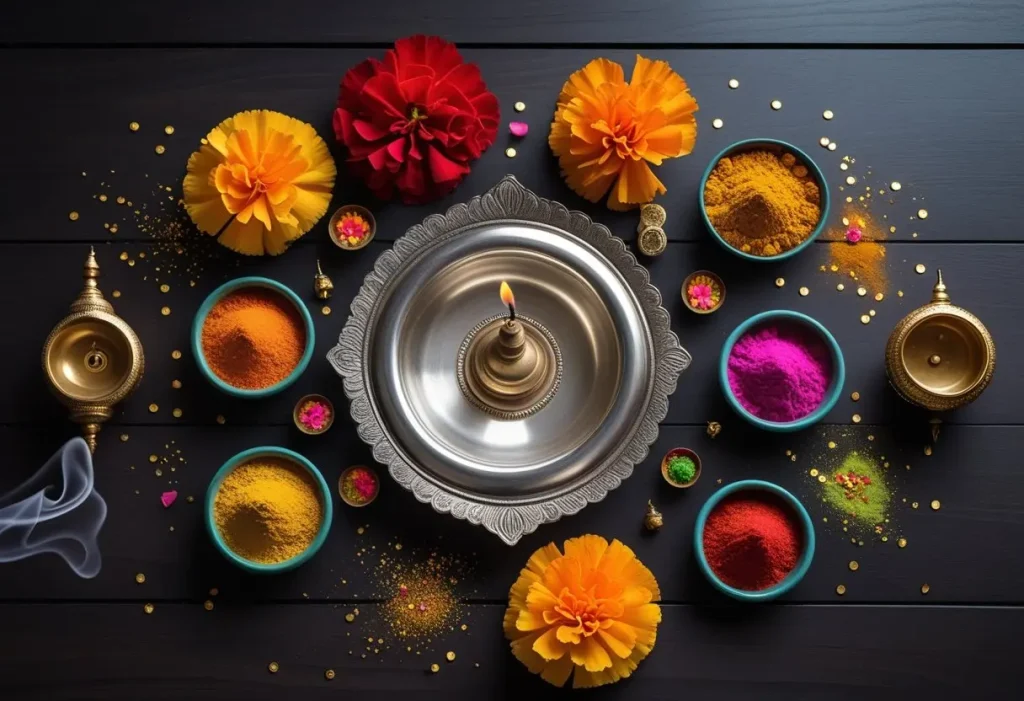
Step-by-Step Guide to Decorating Your Aarti Thali
Let’s move from theory to practice. Aarti Thali Decoration Ideas Here is a detailed, step-by-step guide that forms the foundation for almost all Aarti Thali Decoration Ideas.
Step 1: Cleaning and Preparing the Thali
Begin by thoroughly cleaning your thali. For metal thalis, use a natural cleaner like lemon and baking soda or tamarind to bring out the shine. For wooden or terracotta, ensure it is dry and dust-free. This act of cleansing is itself a sacred preparation.
Step 2: Creating a Base Layer
Instead of placing items directly on the bare metal, create a soft, colorful base.
- Fabric Lining: Cut a circle of rich-colored silk, velvet, or brocade to fit inside the thali. This adds a luxurious feel and prevents items from slipping.
- Rangoli Powder Base: Sprinkle a thin, even layer of vibrant rangoli powder (e.g., yellow, red, or orange) to cover the base of the thali. This creates a stunning backdrop.
- Flower Petal Bed: Create a thick, fragrant bed using rose or marigold petals. This is a classic and beautiful option.
Step 3: Arranging the Core Pooja Items
Place the functional items first, ensuring they are stable and accessible Aarti Thali Decoration Ideas.
- Central Placement: The diya is often the centerpiece. Place it securely in the center.
- Strategic Grouping: Group the small containers for kumkum, haldi, and chandan together on one side. Place the incense holder and bell on the opposite side for balance.
- Stability is Key: Ensure that the diya won’t tip over and the small containers are not too full to spill.
Step 4: Embellishing with Decorative Elements
This is the step where your thali truly comes to life.
- Floral Borders: Create a border around the edge of the thali with whole marigolds or a chain of jasmine flowers (gajra).
- Patterns with Petals: Use different colored petals to create simple Aarti Thali Decoration Ideas patterns like swirls, dots, or the Om symbol around the central diya.
- Adding Sparkle: Carefully place a few sequins, beads, or gota patti around the containers for a festive sparkle.
- Thematic Touches: Add small thematic elements based on the festival (e.g., a small conch for Durga Puja, a flute for Janmashtami) Aarti Thali Decoration Ideas.
Step 5: The Final Check
Hold the thali and gently tilt it to see if anything shifts or falls. Make sure all items are secure and the decoration does not obstruct the handling of the thali during the Aarti Aarti Thali Decoration Ideas.
10+ Stunning Aarti Thali Decoration Ideas with Step-by-Step Themes
Now, let’s explore specific, themed Aarti Thali Decoration Ideas that you can recreate for different occasions.
1. The Classic Marigold & Diya Theme
This is the quintessential Indian Aarti Thali Decoration Idea, perfect for Diwali, Dussehra, or any daily pooja.
- Materials Needed: Brass or silver thali, bright orange marigolds, small diyas, ghee, wicks, kumkum, haldi, bell, incense.
- Step-by-Step:
- Line the thali with a bed of deep red or yellow rangoli powder.
- Place a medium-sized diya in the center.
- Surround the central diya with a ring of whole, small marigold flowers.
- Place 4-5 small diyas, lit or unlit, symmetrically around the thali.
- Arrange the pooja items (kumkum, haldi, etc.) in the spaces between the diyas.
- Create a final border with a garland of marigolds hanging slightly over the edge.
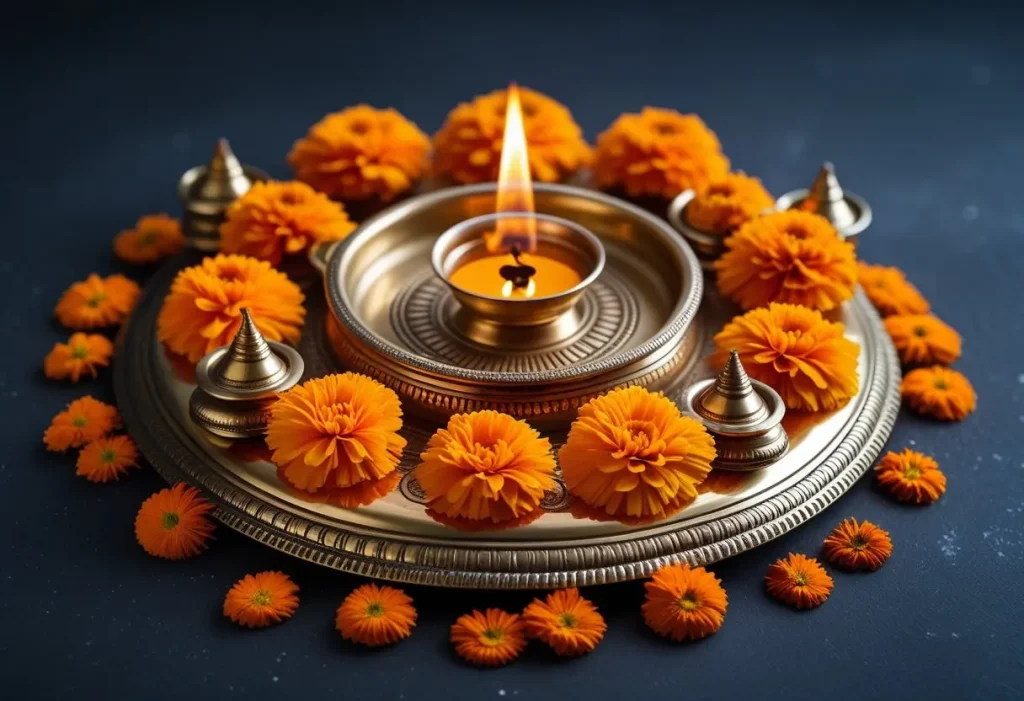
2. The Elegant Rose & Pearl Theme
Ideal for occasions like weddings, Satyanarayan Pooja, or when you want a more sophisticated and serene look.
- Materials Needed: Silver thali, fresh red or pink roses, white pearls (or pearl-shaped beads), white or pink fabric, a white diya, incense Aarti Thali Decoration Ideas.
- Step-by-Step:
- Line the thali with a piece of soft pink or cream-colored silk.
- Place a white or silver diya in the center.
- Remove rose petals and create a concentric circular pattern around the diya.
- Arrange the small pooja containers. Glue or carefully place a string of pearls around the rim of each container Aarti Thali Decoration Ideas.
- Place a few whole roses artfully around the thali.
- Drape a string of pearls along the edge of the thali for a final touch of elegance Aarti Thali Decoration Ideas.
3. The Minimalist & Modern Theme
For those who prefer a clean, uncluttered, and contemporary aesthetic. This style focuses on simplicity and intention.
- Materials Needed: A plain stainless steel or wooden thali, a single type of flower (e.g., white jasmine or a single lotus), a simple brass diya, one or two pooja items.
- Step-by-Step:
- Do not use a fabric or rangoli base. Let the clean metal or wood be the base.
- Place the diya off-center, following the rule of thirds for a modern composition.
- Place a small, neat pile of akshata (rice) next to it.
- Place a single stem of jasmine or a lotus bud diagonally opposite the diya.
- Include only the bell and incense, keeping the thali sparse and meaningful.
4. The Eco-Friendly & Sustainable Theme
Celebrate nature by using only natural, biodegradable, and upcycled materials.
- Materials Needed: A bamboo or terracotta thali, leaves (mango, tulsi), flowers from your garden, a diya made of atta (dough), natural cotton wicks.
- Step-by-Step:
- Use large mango or betel leaves to create a green base inside the thali.
- Use an eco-friendly diya (e.g., one made of clay or kneaded wheat flour).
- Use whole spices like cloves, cardamom, and cinnamon sticks for decoration instead of plastic sequins.
- Arrange wildflowers or tulsi leaves around the diya.
- Use small coconut shell bowls or dried leaf bowls for kumkum and haldi Aarti Thali Decoration Ideas.
5. The Festival-Specific Themed Thali
Tailor your thali to the specific deity and story of the festival.
A. Diwali Aarti Thali Decoration Ideas
Diwali is the festival of lights, so your thali should be bright, golden, and radiant.
- Theme: Gold and Glitter.
- Colors: Gold, yellow, orange, and red.
- Elements: Use plenty of small diyas, gold spray-painted leaves, golden glitter, and yellow marigolds. You can create a small “Om” or “Swastika” symbol in the center using golden beads Aarti Thali Decoration Ideas.
B. Navratri/Durga Puja Aarti Thali Decoration Ideas
This festival honors the divine feminine, Goddess Durga.
- Theme: Red and Powerful.
- Colors: Red, white, and a touch of gold.
- Elements: Use a red fabric base. Decorate with red hibiscus flowers, white jasmine, and a red kumkum dot in the center of the thali. A small red chunri (cloth) piece can be folded and placed on the thali.
C. Janmashtami Aarti Thali Decoration Ideas
Celebrate the birth of Lord Krishna with playful and symbolic elements.
- Theme: Playful and Peacock-Themed.
- Colors: Blue, green, yellow, and peacock feather colors.
- Elements: Use a peacock feather as the central decorative element. Surround it with white butter (maakhan) in a small bowl, a tiny flute, and yellow flowers like marigolds. You can even create a miniature “Govardhan Parvat” from atta (dough) Aarti Thali Decoration Ideas.
D. Ganesh Chaturthi Aarti Thali Decoration Ideas
Honor Lord Ganesha, the remover of obstacles.
- Theme: Auspicious and Red.
- Colors: Red and gold.
- Elements: Use red fabric and durva grass (a trio of grass blades) as a key decorative element. Decorate with modaks (sweet) as part of the offering on the thali. Use red hibiscus flowers Aarti Thali Decoration Ideas.
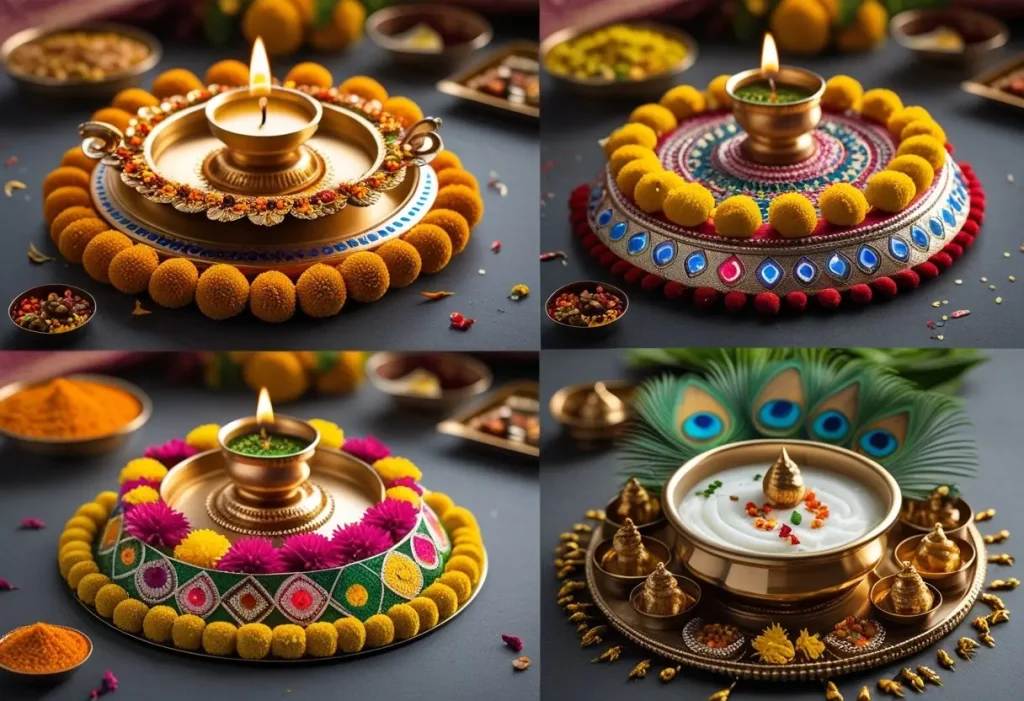
6. The Kids-Friendly & Fun Theme
Involve children in the pooja by creating a thali that is fun, colorful, and safe for them to handle.
- Materials Needed: A lightweight plastic or wooden thali, non-toxic paints, colorful pompoms, paper flowers, a battery-operated tea-light diya Aarti Thali Decoration Ideas.
- Step-by-Step:
- Let the children paint the thali a day in advance.
- Use a battery-operated diya for safety.
- Use colorful pompoms and paper flowers for decoration instead of small items that could be a choking hazard.
- Create smiley faces with kumkum and haldi on the containers.
- Use colorful cereal or candies as a stand-in for akshata.
7. The South Indian Temple-Style Thali
Inspired by the grand poojas of South Indian temples, this style is rich, elaborate, and uses specific items.
- Materials Needed: A large silver or bronze thali, banana leaf, coconut, betel leaves, areca nut, fruits like banana and apple, a large lamp (deepam).
- Step-by-Step:
- Place a clean, fresh banana leaf on the thali.
- Place a large, standing deepam in the center.
- Arrange piles of kumkum, turmeric, and vibhuti (sacred ash) directly on the leaf.
- Place a whole coconut adorned with a kumkum tilak.
- Arrange betel leaves, areca nut, and fruits around the coconut.
- Use jasmine flowers (mullapoo) lavishly around the base of the deepam.
8. The Floating Flower Aarti Thali Idea
A breathtakingly beautiful idea for a water-based pooja or for creating a centerpiece Aarti Thali Decoration Ideas.
- Materials Needed: A wide, deep thali or a decorative bowl, floating candles or small floating diyas, assorted flower petals (rose, marigold), a small bell and incense holder placed on the side Aarti Thali Decoration Ideas.
- Step-by-Step:
- Fill the thali/bowl with water.
- Scatter flower petals on the surface of the water.
- Place 2-3 floating candles or diyas on the water.
- The functional items like the bell and incense can be kept on a separate small plate next to the floating thali. This is more decorative than functional for a circulating Aarti.
9. The Mandala Art Aarti Thali
For the artistically inclined, this involves creating a intricate mandala design on the thali.
- Materials Needed: A plain, flat thali, various colors of fine rangoli powder, a cone for application (or a thin-tipped bottle), a reference mandala pattern.
- Step-by-Step:
- Start with a dot in the center of the thali.
- Slowly build concentric circles of intricate patterns using the rangoli cones. This requires patience.
- Once the mandala is complete, carefully place the diya in the very center.
- Place the other pooja items (kumkum, etc.) symmetrically at the four cardinal points of the mandala so as not to disturb the art.
10. The Themed Thali for Havan/Homa
A Havan thali is simpler and focuses on the offerings for the sacred fire.
- Materials Needed: A sturdy thali, samagri (havan offerings), spoon (sruva), ghee, wooden sticks.
- Decoration Idea: The decoration is minimal. You can line the thali with a simple white cloth and place a few bilva or mango leaves on it before loading it with samagri. The focus is on the purity of the offerings Aarti Thali Decoration Ideas.
Advanced Decoration Techniques and Pro Tips
Once you’ve mastered the basics, you can incorporate these advanced techniques to make your Aarti Thali Decoration Ideas truly exceptional.
Working with Rangoli Powder and Colors
- Creating Gradients: Use multiple shades of the same color (e.g., light yellow to deep orange) to create a stunning gradient effect as your base.
- Stenciling: Use a paper or plastic stencil with a cut-out pattern (like a paisley or floral design). Place it on the thali, sprinkle rangoli powder over it, and carefully lift the stencil to reveal a perfect design.
- Layering: Create a base of one color and then carefully add designs on top with a contrasting color using a cone.
Floral Arrangement Techniques for Thalis
- Symmetry vs. Asymmetry: Traditional thalis often use symmetrical arrangements for balance. Modern thalis can use asymmetrical placement for a dynamic look.
- Color Blocking: Use blocks of solid color with flowers. For example, one half of the thali with yellow marigolds and the other with red roses.
- Creating Height: Use a small piece of floral foam to anchor a few taller flower stems, adding a new dimension to your thali.
Incorporating Fabrics and Textures
- Layering Fabrics: Use a base of a solid color fabric and then layer a piece of sheer, embroidered net on top for a luxurious effect.
- Fabric Folds: Instead of a flat lining, create gentle folds in the fabric for a more organic and rich look Aarti Thali Decoration Ideas.
- Gota Patti and Zari Work: Use strips of gota patti (gold ribbon) to create geometric patterns on the fabric lining before placing the items.
Lighting and Glow Enhancements
- LED Fairy Lights: For a non-fire hazard option, weave a tiny battery-operated LED fairy light string through the flowers. This creates a magical glow.
- Reflective Surfaces: Place a small, round mirror in the center of the thali before placing the diya. The flame will reflect, creating the illusion of multiple lights.
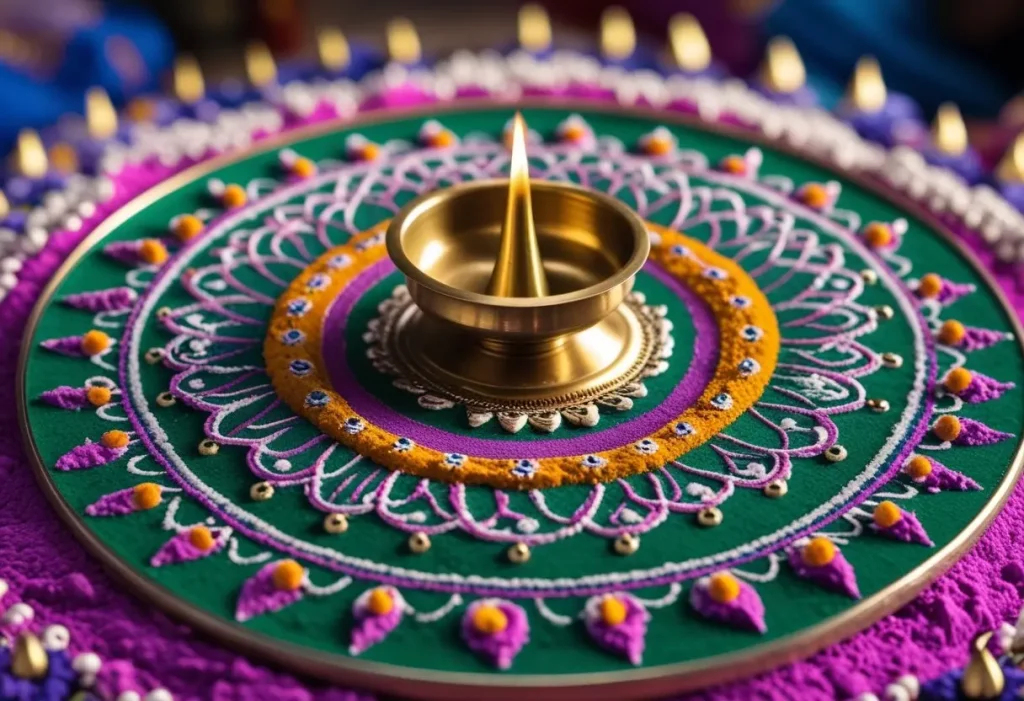
Maintaining and Preserving Your Decorated Aarti Thali
Your beautiful creation doesn’t have to be ephemeral. Here’s how to care for it.
- For Fresh Flower Decorations: These are temporary. Enjoy them for the day and dismantle the thali after the pooja. Remove flowers to prevent staining the metal.
- For Non-Perishable Decorations: If you’ve used fabrics, beads, and sequins, you can carefully store the entire thali in a cool, dry place, covered with a soft cloth or in a box to prevent dust accumulation.
- Cleaning Post-Pooja: Clean the thali immediately after use to prevent ghee and kumkum from staining. Remove all decorative elements and wash the thali with warm water and a mild detergent. Dry it thoroughly before storing.
Common Mistakes to Avoid in Aarti Thali Decoration
Even with the best Aarti Thali Decoration Ideas, small mistakes can hamper the experience.
- Overcrowding: The most common error. It makes the thali difficult to handle and can be a fire hazard. Remember, simplicity is often more elegant.
- Ignoring Functionality: The thali must be functional. Ensure you can comfortably hold it, ring the bell, and wave it without items falling off.
- Using Toxic Materials: Avoid using synthetic glues, toxic paints, or non-heat-resistant materials near the diya.
- Unstable Diya Placement: Always ensure the main diya is stable and won’t tip over when the thali is moved in a circular motion.
- Forgetting the Season and Festival: A heavy, opulent thali might not be suitable for a somber occasion. Match the decoration’s mood to the event.
Frequently Asked Questions (FAQ) About Aarti Thali Decoration Ideas
Here are answers to the 15 most trending questions about Aarti Thali Decoration Ideas, sourced from Google’s “People Also Ask” and related searches.
1. What are some simple Aarti Thali decoration ideas for daily pooja?
For daily pooja, keep it simple and functional. A clean thali with a diya, incense, and the essential items is perfect. You can add a single flower or a small ring of petals around the diya for a touch of beauty without extra effort.
2. Which flowers are considered most auspicious for Aarti Thali decoration?
Marigold is the most common and highly auspicious flower. Others include lotus (for Goddess Lakshmi), red hibiscus (for Goddess Durga), jasmine, and roses. Tulsi leaves are considered sacred for Lord Vishnu.
3. How can I decorate my Aarti Thali without flowers?
You can use colorful rangoli powders to create designs, use leaves like mango or betel, add beads and sequins, use fabric with beautiful prints, or even use whole spices like cloves and cardamom for a fragrant, natural look.
4. What are some unique themes for a Diwali Aarti Thali?
Beyond the classic gold theme, consider a “White Diwali” theme with white flowers and pearls for peace, a “Royal Blue” theme with blue flowers and gems for a regal look, or a “Sustainable Diwali” theme with terracotta and natural elements.
5. How do I make my Aarti Thali look rich and luxurious?
Use a silver thali as a base. Incorporate rich fabrics like silk or velvet, use real pearls or semi-precious stones, gold-colored embellishments (gota patti), and arrange flowers in a symmetrical, abundant manner.
6. Are there any safety precautions for decorating with diyas?
Absolutely. Ensure the diya is stable and won’t tip over. Keep all flammable materials like loose petals, fabric, and incense away from the direct path of the flame. Never leave a lit thali unattended.
7. Can I use artificial flowers for Aarti Thali decoration?
Yes, high-quality silk or paper artificial flowers can be used, especially for long events or if you have allergies. However, fresh flowers are always preferred for their fragrance and natural purity in traditional practices.
8. What is the significance of the color red in Aarti Thali decoration?
Red is a powerful color in Hinduism, symbolizing purity, sensuality, marital bliss, and the divine feminine energy (Shakti). It is considered highly auspicious and is often used in festival decorations.
9. How to decorate a Aarti Thali for a wedding ceremony?
A wedding thali should be grand. Use a large silver or gold-threaded thali. Decorate with red roses and jasmine, plenty of gold sequins and pearls, and incorporate symbols of marriage like a tiny kalash (pot) or a pair of birds.
10. What are some eco-friendly Aarti Thali decoration ideas?
Use a bamboo or terracotta thali. Decorate with leaves and flowers from your garden. Use diyas made of clay or kneaded wheat flour (atta). Avoid plastic and glitter; use natural materials like rice, grains, and spices for decoration.
11. How can I involve my children in decorating the Aarti Thali?
Give them a separate, safe thali to decorate. Provide them with non-toxic materials like paper flowers, safe glue, pompoms, and a battery-operated diya. This makes them feel involved and teaches them about traditions in a fun way.
12. What are the essential items that must be on every Aarti Thali?
The non-negotiable items are: a Diya (lamp), Incense (agarbatti), Bell (ghanta), and offerings of Kumkum, Haldi, Akshata (rice), and Flowers. Water and a sweet Prasad are also standard.
13. How to create a balanced and symmetrical Aarti Thali design?
Start by placing the diya in the exact center. Then, place matching items (like kumkum and haldi containers) directly opposite each other. Use an even number of decorative elements (e.g., 4 small diyas, 8 flowers) to maintain symmetry.
14. Can I use crystals and gemstones on my Aarti Thali?
Yes, many people use crystals like clear quartz (for amplification), rose quartz (for love), or lapis lazuli (for wisdom) to infuse the thali with specific energies. Ensure they are clean and placed securely.
15. Where can I buy unique Aarti Thalis and decoration materials online?
You can find a beautiful selection on our website, CozyNestDecor.pro, which curates handmade and artistic pooja items. Other great options include Amazon, Etsy (for handmade pieces), and specialized Indian pooja item stores like PujaShoppee or ePooja.
Conclusion: Your Aarti Thali, Your Divine Expression
The journey of exploring Aarti Thali Decoration Ideas is much more than a quest for beauty; it is a path to deeper devotion and personal expression. Your Aarti thali is a reflection of your love, your creativity, and your reverence for the divine. From the simplest daily offering adorned with a single flower to the most elaborate festival centerpiece dripping with marigolds and gold, each thali you create carries the unique signature of your spirit.
We hope this ultimate guide has provided you with not just inspiration, but also the practical knowledge and confidence to experiment and create. Remember, the best Aarti Thali Decoration Ideas are the ones that resonate with your heart and enhance your spiritual practice. So, gather your materials, light the diya of imagination within you, and transform your sacred thali into a masterpiece of devotion. For more inspiration on creating a cozy and spiritual home, explore the other articles on CozyNestDecor.pro.
Internal Linking Suggestions:
- Link to other blog posts like “10 Diwali Home Decoration Ideas to Create a Cozy Ambiance” or “How to Set Up a Beautiful Home Mandir” within the relevant sections.
- Link to product pages for pooja thalis, diyas, and other decor items available on cozynestdecor.pro.
External Linking Suggestions:
- Link to authoritative sources like Wikipedia for explanations of Aarti or specific festivals.
- Link to cultural websites like https://www.hindu-blog.com/ for deeper dives into symbolism.
- Link to reputable rangoli art tutorials on YouTube for visual learners.